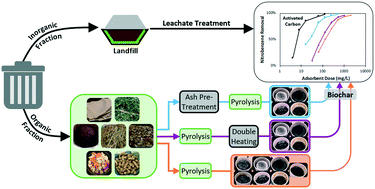Evaluating landfill leachate treatment by organic municipal solid waste-derived biochar†
Abstract
Transforming the organic fraction of municipal solid waste (OFMSW) into biochar to reduce fugitive landfill emissions and control organic micropollutants (OMP) during landfill leachate treatment could provide a new circular economy organics diversion approach. However, research on landfill leachate treatment under consistent, representative conditions with biochar derived from the wide range of OFMSW components is needed. Further, the competitive nature of leachate dissolved organic matter (DOM) for biochar adsorption sites has not been examined. To this end, biochars were produced from seven diverse OFMSW types and batch tested using two representative organic contaminants. To evaluate leachate DOM impact on OMP removal and fouling mitigation with biochar enhancement methods, experiments were performed with three background matrices (deionized water, synthetic leachate, real leachate) and two enhancement methods (ash-pretreatment, double-heating). Since evaluating all possible OFMSW feedstock combinations is infeasible, fundamental relationships between individual feedstocks and biochar properties were evaluated. Overall, biochar performance varied substantially; the dose to achieve a given target removal spanned an order of magnitude between the OFMSW feedstocks. Also, the presence of leachate DOM more negatively impacted the performance of all biochars relative to the benchmark adsorbent activated carbon. Finally, the enhancement methods altered biochar pore structure by increasing micropore and slightly decreasing non-micropore surface areas, resulting in improved adsorption capacity (by 23 to 93%). By providing the basis for a low-cost, enhanced leachate treatment method, this study could incentivize a novel organics diversion approach that reduces climate change impacts, harvests energy from waste, and reduces landfill air emissions.



 Please wait while we load your content...
Please wait while we load your content...
